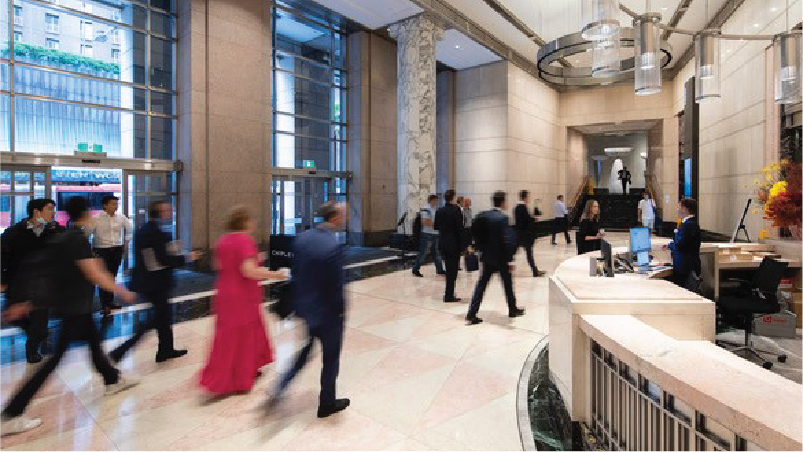Now there are seven CBDs in Sydney alone: OOH is back post-pandemic with the data and scale – and the high-powered business audience is there for the taking

Covid’s sustained disruption created a high stakes game in the rapidly changing media landscape.
Exactly two years ago, Out of Home’s world – and audiences – collapsed with Covid. But now people are back to work in numbers, and CBDs have multiplied. There are now seven in Sydney alone, writes oOh!media’s Bel Harper, which means advertisers need to adjust their strategies to win.
Two years ago this week, we experienced our first nationwide lockdown, and for the Out of Home industry, there is no doubt the pandemic gave us a shakeup. Before Covid hit, we were in our element. We had years of sustained audience growth behind us, and we were poised to capitalise on our investment in rich transactional data that we had mapped to audiences at location. As an industry, we knew we had the ability to reach these defined audience segments quickly and at significant scale due to our advanced, standardised industry measurement. The future looked bright.
Covid’s sustained disruption created a high stakes game in the rapidly changing media landscape. It was a time of big bets for our largest industry players – we saw some of the most high-profile contracts change hands mid-pandemic.
What does this new world look like? It’s a question that leaders are contemplating right now as we adapt and respond to the wants and needs of our employees. It’s a fine balancing act between our work, family life, our values, productivity and mental wellbeing. Swinburne University’s Hybrid Working 2.0 report found 73 per cent of employees wanted continued workplace flexibility, with Gen Z placing twice as much importance on it as Baby Boomers. Adding to that, 43 per cent of workers say it’s a dealbreaker if their employer refuses to adopt a hybrid working model1.
How, where and when can audiences be reached in the physical world of Out of Home today? Pre-pandemic, the inner city CBD’s attracted 15 per cent of the state’s workforce, on average2. In Sydney’s CBD, about half of that audience are business professionals, decision makers and senior executives3, and around five per cent of the Sydney metro audience resides in the CBD’s local government area4. Increasing urban sprawl and population growth mean we’ve seen a proliferation of central business districts spread across metropolitan areas, and far beyond the primary CBD. In Sydney, seven CBDs, including Macquarie Park, North Sydney and Parramatta, are home to some of the largest global and Australian businesses representing all sectors, attracting executives and business audiences who reside across the wider metro catchment.
These changes have altered media consumption as we knew it. Reaching business professionals and high-value consumers means considering what today’s normal looks like, including hybrid working and the emergence of big businesses continuing to expand into suburban-based CBDs. These are the places the vast majority of people now live and work. The concept of ‘one CBD to rule them all’ is now a shifting paradigm.
There is no doubt Covid was highly disruptive to our Airports and Office tower networks. Normally buzzing with suits and C-suites, we saw just a fraction of their 3 million-plus 2019 audience levels during the pandemic5. But things are looking up. Offices and Airports will remain the primary place of our work life and business travel. These marble-clad towers, terminals and business lounges are home to Australia’s blue-chip businesses – and therefore our most powerful decision makers.
As audiences come back, the attributes that make them such unique media environments – long dwell times on digital screens that have integrated breaking news and flight time information – are key to gaining and retaining eyeballs. This is at a time when marketers need to lean in to and value tight audience targeting, brand safety and attention.
Over 90 per cent of us want to come back to the office1. Between border closures and lockdowns, Australia is intrinsically a nation of flyers. Pre-pandemic Melbourne to Sydney was the world’s second busiest domestic route, and those numbers bounced back quickly when restrictions eased. Qantas’ Q2 projections are now at 90 to 100 per cent of 2019 levels.
At oOh!, our big nod of confidence to the return of travel is our commitment and renewal of Qantas and our major Airport contracts, with all new media assets at Melbourne and Brisbane Airports, and Qantas Lounges.
Adapting to change is not about destroying and starting again. In the case of the Out of Home world, it’s about re-setting, using data to inform how our audience moves and consumes, and enabling leading brands to engage with them efficiently, at scale. And as we emerge from the Covid storm, apply the wise words of Bertha Calloway: “We cannot direct the wind, but we can adjust the sails.”
- Swinburne University; Hybrid Working 2.0: Humanising the office; December 2021
- Grattan; Australian CBD’s share of entire city workforce; based on analysis of ABS (2016a) and ABS (2011a) data
- City of Sydney; Floorspace and employment survey; 2017; Business Professionals defined as Finance and Financial Industries, Professional and Business Services, Information and Communications Technologies (ICT)
- City of Sydney, Estimated Resident Population for City of Sydney; 2020
- Smart Reach, Quantium data, Total Potential Audience oOh! Office and Fly formats; 4wks
